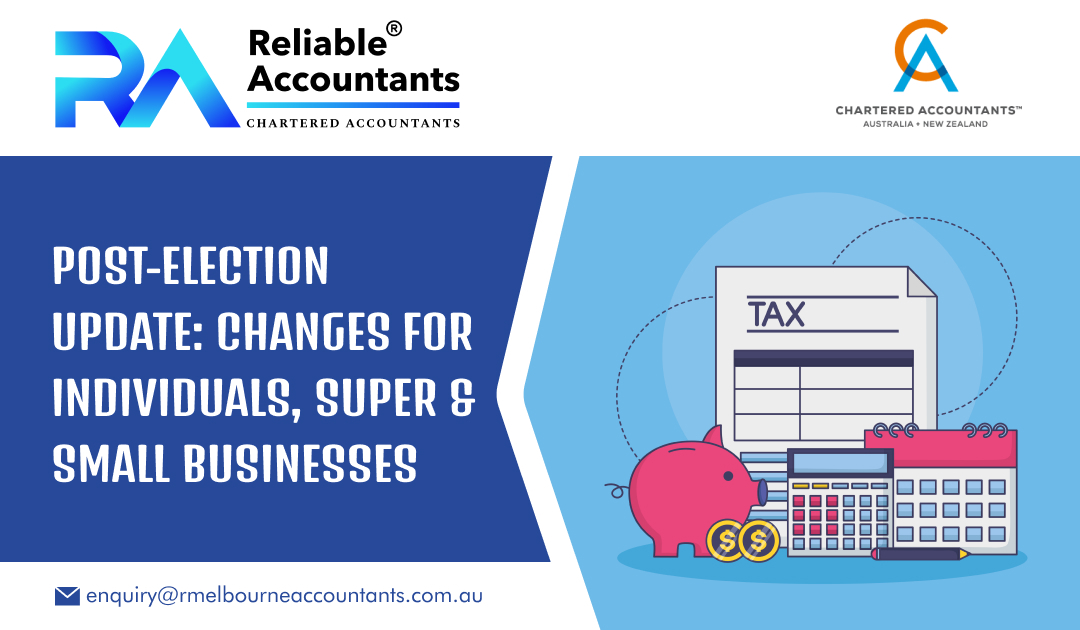The Labor Party has formed a government, achieving a majority in the House of Representatives on its own. In the Senate, Labor is expected to gain three more seats during the half Senate election. While Labor controls the House, it will still need some support to pass legislation in the Senate. We will explore the commitments made and the unresolved issues from the previous term.
Individuals
. Personal income tax cuts
The 2025–26 federal budget introduces modest income tax cuts for all taxpayers, starting from 1 July 2026 and again from 1 July 2027.The tax rate for the $18,201–$45,000 income bracket will drop from 16% to 15% in 2026–27, and further to 14% from 2027–28. This measure, costing $648 million over four years, will deliver maximum annual savings of $268 in 2026–27 and $536 from 2027–28.
The legislation was passed by Parliament on 26 March 2025.
- $1,000 instant work-related expenses tax deduction
The Government will introduce a $1,000 shortcut work-related deduction for taxpayers earning labour income. This simplified deduction can be claimed directly on tax returns, but those with higher work-related expenses can still claim the actual amount under existing rules. The shortcut is only available to individuals with labour income. Those earning only business or investment income won’t qualify. Other non-work-related deductions can still be claimed separately, and tax returns will still need to be lodged as usual.
- Energy rebate extended
The 2025–26 federal budget extends energy bill relief for households and small businesses. From 1 July 2025, eligible households and small businesses will receive a further $150 energy rebate, applied automatically to electricity bills in quarterly instalments through to the end of 2025.
- Cheaper home batteries
The Government has decided to lower the cost of home batteries starting 1 July 2025. Under this initiative, households will be eligible for a 30% discount on the installed cost of a standard battery, resulting in savings of approximately $4,000. This new measure builds on and expands the existing Small-scale Renewable Energy Scheme.
- 5% deposit scheme for first-home buyers
The Government is introducing a 5% deposit scheme for all Australian first-home buyers. This will allow eligible buyers to purchase a property with just a 5% deposit, with the Government covering the cost of LMI. The scheme expands on the existing First Home Buyer program, with higher property price limits and no caps on places or income, as outlined in the media release.Currently, the Home Guarantee Scheme has limits on available places and income eligibility. It’s available to Australian citizens or permanent residents who have never owned property, or haven’t owned property in the past 10 years, and is only for owner-occupiers.
- 20% Reduction in Student Loan Debt
The Government has announced a 20% reduction in all study and training support loans, effective from 1 July 2025. After the legislation passes, the Australian Taxation Office (ATO) will apply this one-off reduction to an individual’s HELP or student loan balance before indexation on 1 June 2025.
This debt reduction comes alongside changes to the repayment system, which will raise the minimum repayment threshold to $67,000 for the 2025–26 year. Repayments will only be calculated on income above this threshold, rather than on total annual income.
Superannuation
. Tax on super balances above $3m
The proposed Division 296 tax on superannuation balances above $3 million lapsed when Parliament dissolved. The key question now is whether the Government will push this reform through with The Greens’ support.
Greens Senator Nick McKim has suggested lowering the $3 million threshold to $2 million and indexing it to inflation. He also linked his support for the tax to a ban on super funds borrowing to finance investments.
If passed, Division 296, originally set to start from 1 July 2025, would raise the tax rate to 30% on earnings from super balances above $3 million. The calculation would consider growth in super balances over the financial year, including contributions, withdrawals, and both realised and unrealised gains, allowing negative earnings to be carried forward to offset future years.
Small Business
- Extending the instant asset write-off for small businesses
The instant asset write-off threshold has been raised to $20,000 for the 2024–25 financial year, following legislation passed on 26 March 2025. The Government has also committed to extending this $20,000 threshold through to 30 June 2026, continuing support for small business investment.
- National small business strategy
The Government has opened a consultation on its new National Small Business Strategy. The focus isn’t on small businesses themselves, but on fixing how government systems interact with them, making it easier to deal with rules, forms, and processes across different departments and levels of government.
Energy
- Green Aluminium Production Credit
The Government has allocated $2 billion for a new Green Aluminium Production Credit to help Australian smelters switch to renewable electricity by 2036. There are four smelters eligible for this funding.
The aluminium industry is a major focus because aluminium is the second most-used metal globally and accounts for around 10% of Australia’s electricity demand. Tomago Aluminium, in NSW, is the country’s largest electricity user, with energy making up 40% of its costs. Transitioning to green energy will transform the entire industry.
Under the scheme, smelters can negotiate emissions-linked credits for every tonne of green aluminium produced. These credits will be available for up to 10 years, with rates depending on the facility’s efforts to cut Scope 2 emissions, which are emissions from purchased electricity about 85% of emissions in aluminium production.

